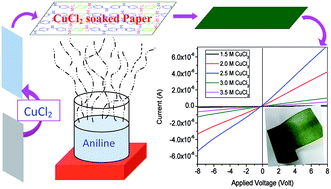Tuning of electrical and optical properties of polyaniline incorporated functional paper for flexible circuits through oxidative chemical polymerization
Abstract
An organic semiconductor material made of polyaniline with outstanding physical properties was prepared on a flexible paper substrate. Oxidative chemical polymerization, a straightforward and cost effective technique for large scale synthesis has been employed for the preparation of the polymer on the paper substrate. CuCl2 has been chosen as a polymerizing agent for the oxidative chemical polymerization process. The prepared polymer semiconductor has become an ideal system to explore this outstanding recipe of chemistry and physics. Formation of polaron and bipolaron defect energy states in the polymer lattice facilitates exceptional electrical hole transport through the polymer chain, providing an electrical sheet resistance varying from 5.0 × 105 Ω □−1 to 2.8 × 107 Ω □−1. The optical band gap as obtained from the absorbance study was found to be in the range of 2.49 eV to 2.62 eV, which is suitable for the design of semiconductor devices. Most importantly, this article reports an effective way of tuning the optical and electrical properties of the prepared semiconductor, achieved through controlling the degree of oxidation during polymerization and thus bringing a control over the defect energy states. Along with the controllable electrical and optical properties, the flexibility of the paper substrates provides an extra merit to such polymer systems for designing paper based low cost flexible devices.


 Please wait while we load your content...
Please wait while we load your content...